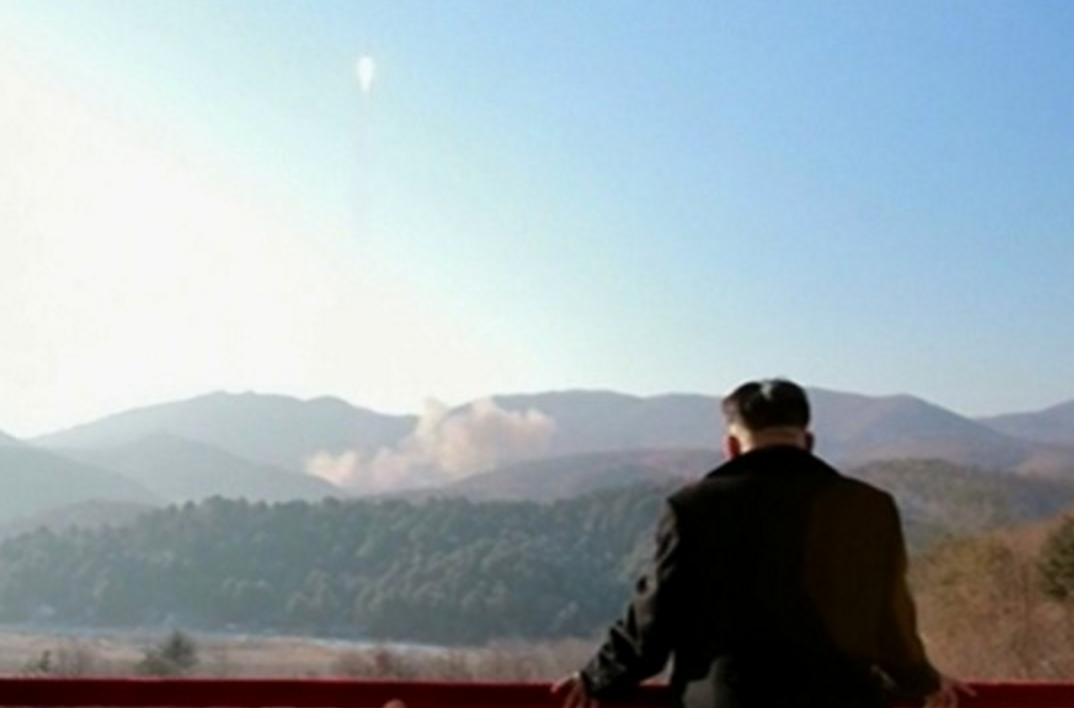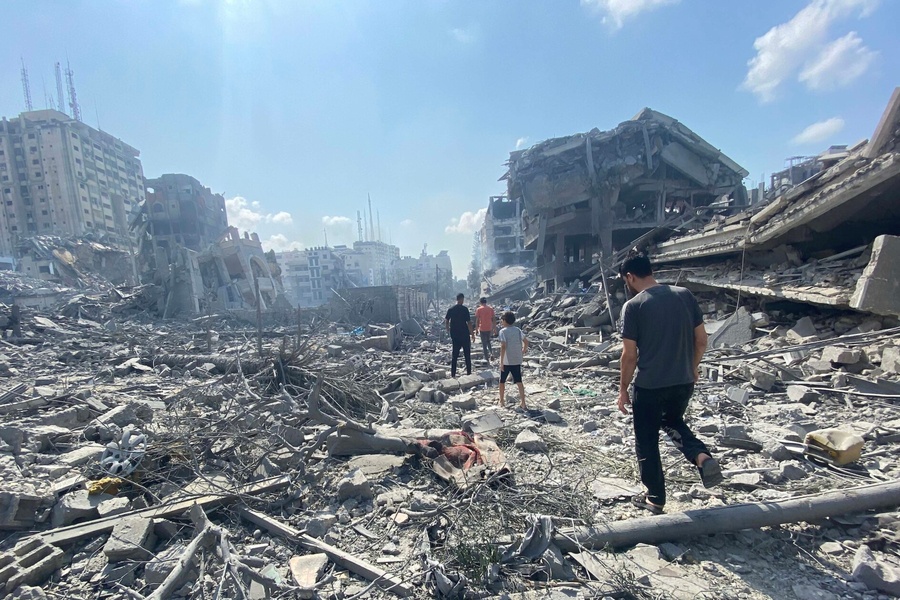Thoughts on the North Korean Nuclear Test and Satellite Launch
International responses to North Korea’s nuclear and missile tests have taken on a highly ritualized quality that we have seen before: there is a test; there is outrage; there is condemnation; there is another test; then there is escalation, de-escalation and ultimately a return to an ever-changing new normal.

Published by The Lawfare Institute
in Cooperation With

International responses to North Korea’s nuclear and missile tests have taken on a highly ritualized quality that we have seen before: there is a test; there is outrage; there is condemnation; there is another test; then there is escalation, de-escalation and ultimately a return to an ever-changing new normal. In this post, I want to look at three issues: the relationship of the satellite test to the missile and nuclear programs; the question of North Korean motives, which appear increasingly inward-looking and solipsistic; and the perennial “what is to be done” question, centering almost entirely on what to expect of China.
The answer to this last question is more complicated than it appears. China’s fundamental view of the situation has not changed; it believes that resolution of the North Korean issue depends on the US and a return to the Six Party Talks. Yet Beijing is facing some new constraints. First, it is in the embarrassing position of having to do something at the UN Security Council given past resolutions that Beijing itself has shaped. And second, international tolerance is declining not only for North Korea’s behavior but also for Chinese even-handedness towards it, making the pursuit of secondary sanctions and even military options much more likely.
It’s important to consider this weekend’s missile test in light of the nuclear test a month ago; this weekend’s events are the second test in the ritualized cycle I describe, not the first. The first thing to underline on this score is that nuclear weapons clearly have internal as well as external purposes for the DPRK. The announcement of the nuclear test was included in a short statement saying that the test was ordered directly by Kim Jong Un “on behalf of” the Korean Workers Party Central Committee. This formulation is also worth noting; it comports with the convening of a Party Congress later in the year, the first since 1980. The longer explanation spends almost as much time on the technological achievement as on its actual strategic purpose. It is wrong to believe that North Korea has consistently sought to avoid denuclearization; there have been moments of serious negotiations, most notably in 1994 and again in 2007-8. But at this juncture, the simultaneous pursuit of economic development and nuclear weapons is working. It is becoming harder and harder to think that North Korea will come to the table unless China changes course. Nuclear weapons have become a critical dimension of the regime’s and the party’s DNA.
With respect to the strategic purpose of the nuclear test, there are a number of curious components of the North Korean statement. First, there is the apparently earnest North Korean effort to portray itself as a responsible nuclear power. According to the longer statement, this status comes with obligations such as non-proliferation and—more puzzling—a statement of no first use, which the United States does not maintain vis-à-vis North Korea because of its failure to abide by its commitments under the Non-Proliferation Treaty. The claim to “responsible nuclear power” status ironically makes it far harder to enter into negotiations with the country; would doing so acknowledge this self-proclaimed status?
More confusing still was the no first use claim. North Korea repeats endlessly that it is vulnerable to nuclear threat from the US. Yet the most likely scenario for war is the escalation of a conventional conflict in which the US and the South could prevail without using nuclear weapons. Under such circumstances, with the regime at risk, could we be assured that North Korea would not use a demonstration strike or a variety of other probes—including targeting US assets in the region—in order to stave off defeat? The short answer is “no.”
As a result, we are going to see a renewed attention to a variety of strategic and force deployment questions coming out of the nuclear test. First up is the deployment of Terminal High Altitude Area Defense (THAAD) to South Korea, but that is only the beginning. Also on the agenda will be ongoing cooperation with Japan on intelligence sharing and ballistic missile defense and the development of prompt strike conventional capabilities that would expand options if war were to occur. On these points, Brad Roberts’ outstanding new book, The Case for U.S. Nuclear Weapons in the 21st Century, is a great place to start.
This brings us to the launch, on which we should begin by dispensing with the obvious: although nominally a “satellite launch,” the North Korean test is clearly another investment in the regime’s missile program. This observation is likely true as a matter of fact, and it is unambiguously true as a matter of international law.
According to the South Korean National Intelligence Service (Yonhap), the current satellite weighed about 200 kilos, double that of the satellite carried by the successful launch in December 2012. But the “earth observation” satellite launched in 2012 and nominally designed to track crop production—the so-called called Kwangmyŏngsŏng-3 Unit 2—appeared to fail almost immediately. As of this writing, moreover, there is no evidence of transmission from the new satellite (despite lavish congratulations from meteorological experts in North Korea). Was there ever really a satellite to begin with?
With respect to the launch vehicle, the best early summary of what we know is from Melissa Hanham at Arms Control Wonk, replete with coverage of the domestic propaganda around the launch, a subject to which we return below (the orders, Kim Jong Un signing them, the patriotic news coverage). The 2016 Kwangmyongsong launch vehicle appears from initial comparisons to be broadly similar to the Unha-3, although more will be known from recovery of the early stage debris, as was done in 2012.
Whether this way of developing an ICBM capability is efficient is another question. The liabilities of the current effort are long and detailed by both John Shilling in a recent post at 38North and Jeffrey Lewis in his classic primer of a year ago on the what he calls “the great miniaturization debate,” also at 38North. The current engines probably do not have adequate thrust to deliver a warhead; the capacity to adequately miniaturize a weapon remains in doubt; and accuracy is more of a challenge as ranges lengthen. Above all, neither intermediate nor intercontinental missiles capable of carrying a serious payload have been flight tested, leaving doubts about their capacity to survive in-flight turbulence and re-entry. Moreover, the space launch vehicles are fixed above ground and too large to be made mobile; they are at least in theory highly vulnerable to preemption.
Nonetheless, missile development is a learning process, and not for the North Koreans alone. In a little-noticed action last month, Treasury announced new sanctions on eleven Iranian entities and individuals associated with that country‘s ballistic missile program. However, two of them were explicitly singled out as cooperating with the North Koreans on booster rocket technology.
North Korea has repeatedly asserted its right to the peaceful use of space and has done so again. From a legal perspective UNSC 1874 closed down North Korean arguments in this regard. The resolution:
2. Demands that the DPRK not conduct any further nuclear test or any launch using ballistic missile technology;
3. Decides that the DPRK shall suspend all activities related to its ballistic missile programme and in this context re-establish its pre-existing commitments to a moratorium on missile launches.”
These demands and decision clearly have not influenced North Korean behavior, but they equally clearly did place constraints on China’s freedom of maneuver. No longer could Beijing call for calm in the face of blatant violations of UN Security Council resolutions that it had an important role in shaping; I return to this issue below.
What about North Korean motives? I am increasingly skeptical of interpretations that see these tests as part of some complex strategic dance designed to get international attention. There was, after all, nothing obvious in the international setting that anticipated either the January nuclear test or the satellite launch. The tests did not respond to any obvious provocation on the part of South Korea or the US. Except in 2006, tests have not proven a successful means for North Korea to secure negotiations, compromises or rewards either; to the contrary, such tests have routinely generated new sanctions and condemnation.
If not as an international bargaining chip, what is the alternative explanation for these tests? The DPRK leadership sees nuclear weapons and the missile program as permanent features not only of North Korea’s grand strategy—as the country now openly states—but of Kim Jong Un’s domestic messaging as well.
Evidence in support of this interpretation abounds, including the attention given to Kim Jong Un’s and the Party’s role in directing the launch, in the connection of the test to the DPRK’s technological advance, and above all in the recurrent trope of standing up to the American imperialists. After the Moranbong Band’s show, with the 2012 satellite launch in the background, my favorite piece of North Korean propaganda is the postcard below, which makes the point: “don’t recklessly go berserk; wipe America off the face of the earth.”
If this interpretation is correct, expect more nuclear and missile propaganda, not less, in the run-up to the 7th Party Congress this summer. The South Korean National Intelligence Service is already briefing Korean lawmakers on the possibility of a fifth nuclear test.
So what is to be done?
Is there any hope of getting China to do anything through diplomacy or is the only route to Beijing through its stomach: by raising the costs of inaction? Despite my deep skepticism about how far China is willing to go to “deliver” Pyongyang, it is too early to prejudge the outcome of the negotiations in New York. China signed on to strong UNSC statements at the time of both the nuclear test and satellite launch that reflect its own prior commitments. The statement following the missile test—of necessity a consensus document—shows the bind that China is in:
The members of the Security Council restated their intent to develop significant measures in a new Security Council resolution in response to the nuclear test conducted by the DPRK on January 6, 2016, in grave violation of the DPRK’s international obligations.
The members of the Security Council also recalled that they have previously expressed their determination to take “further significant measures” in the event of another DPRK launch. In line with this commitment and the gravity of this most recent violation, the members of the Security Council will adopt expeditiously a new Security Council resolution with such measures in response to these dangerous and serious violations.
South Korea has also been particularly dogged on the point this time around. A succession of high-ranking South Korean officials—Prime Minister Hwang Kyo-ahn; Deputy Chief of the Office of National Security at the Blue House Cho Tae-yong and spokesmen for both the Ministry of Unification and the Ministry of Foreign Affairs promised that the North would experience “serious consequences.” But as Dan Pinkston pointed out to me—and the South Korean press subsequently confirmed—this statement was modified by the clause “from the international community.” The benefits of President Park’s diplomatic strategy toward China are increasingly coming under challenge; what has Beijing actually done to ameliorate the situation?
As usual, China is doing everything in its power to lower expectations and to shift responsibility back to the US. Virtually all of China’s long-standing arguments about why it cannot lead on this issue have been on display (the following draws on the MOFA spokesman’s remarks since the nuclear test):
-
Special Representative Wu Dawei was not insulted on his recent visit to Pyongyang by the announcement on the very day he arrived that the North Koreans would test; his visit was “in itself, a very serious diplomatic endeavor by the Chinese side.”
-
The nuclear and missile tests since 2008 have been entirely due to the stance of the US (“During the stalemate of the Six-Party Talks, in response to relevant countries’ constant outcry for pressure and sanctions, the DPRK started nuclear test and conducted it over and over again. In this sense, the DPRK did slap the relevant country across the face. As for whose face did the DPRK slap, the country itself knows well.”)
-
China conceives the Six Party Talks as the appropriate venue for pursuing denuclearization, as do I; at some point, the negotiations simply have to resume. But China takes a fundamentally passive role, encouraging “all parties concerned to reach [the] aforementioned consensus [contained in the September 2005 joint statement].” This effort has failed for “some well-known reasons which have nothing to do with China….” (see also Xinhua).
-
Not only is China opposed to any unilateral sanctions—relying on its veto at the Security Council to shape the multilateral effort—but it is opposed to any other form of pressure on North Korea as well; indeed, Beijing has come close to offering a virtual security guarantee to the Kim dynasty, with all of the moral hazard problems such a guarantee implies (“As a close neighbor of the Korean Peninsula, we will by no means allow war or instability on the Peninsula.”)
This time, however, the political alignment in the US is trending against a continuation of strategic patience in its current form. Those arguing for a return to negotiations seem to be living in a parallel universe from where elite political opinion is now trending. In the Republican debate over the weekend, Jeb Bush—among the more sober candidates with respect to foreign policy and living under the shadow of his brother’s invasion of Iraq—openly pondered a preemptive strike.
Concrete actions are likely to move along two fronts. The first quickly caught the attention of China’s foreign ministry, which issued formal representations over the issue: the decision by the US and the ROK to open formal negotiations on the deployment of THAAD. The second line of action is the pursuit of secondary sanctions, which China also vociferously opposes. It is likely that the response to these actions in Beijing will parallel the response to them in Pyongyang: to hunker down and pull in the horns. But at least, the actions might clarify the differences: that the United States and South Korea are going to protect themselves regardless of what Beijing thinks. Whether China makes any adjustments to its mantra about the need to return to the Six Party Talks will be the most revealing outcome of this most recent nuclear and missile test cycle.
Editor's note: This post is adapted from the author's posts on the North Korea: Witness to Transformation blog.





-(1).png?sfvrsn=fc10bb5f_5)
